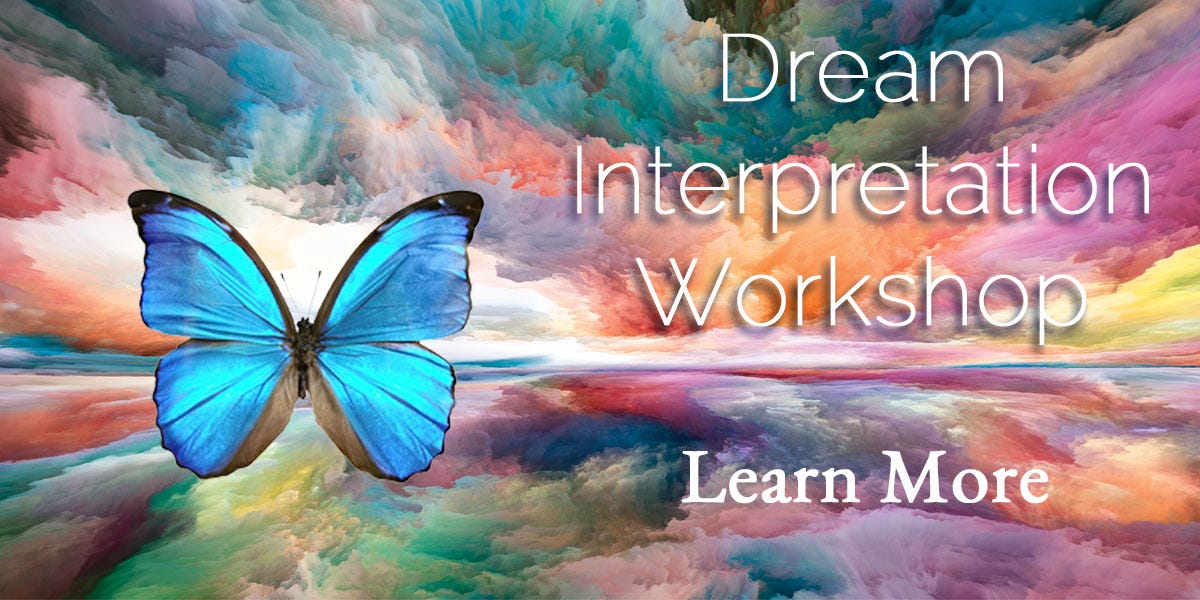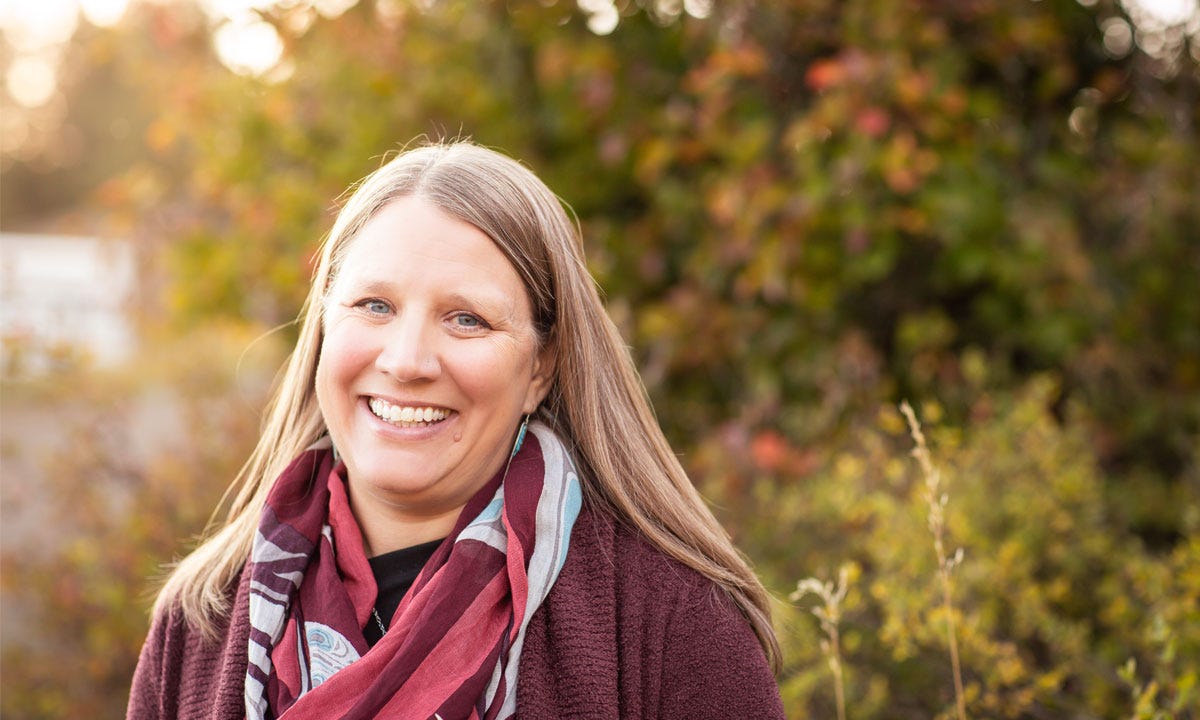Dream Interpretation Workshop - Thursday, April 3 at 11am - This two hour workshop only has a max of 5 students so you’re sure to get individualized support!
Coming in April - 30-day Intuition Project for Paid Subscribers! Transform your your intuitive abilities. Stay tuned for details.
Listening to your dreams is a beautiful way to connect with your soul, even if your dreams are not calming or captivating. Interpreting dreams helps us dissolve unsettling emotions. It brings purpose to what may otherwise seem meaningless or even unnerving.
All you need to do is remember one image, one still frame, from your dream. You don’t have to know the whole story. If you only remember bits and pieces or just one little piece, that’s perfect. One image is archetypal and carries both personal meaning and universal symbolism.
Below is a brief reflective process for working with a simple dream image. This is a mini-inquiry showing the of the type of deeper process we do in my Dream Interpretation workshop.
Make sure you do the first five steps below BEFORE you look up the meaning of your dream online or in a dream dictionary. This way, you’ll understand more about the context of your dream for you before you fill the space with impersonal data.
Step 1 - Write Down the Image
Write down what the image was. Even if this is one or two sentences, it doesn’t matter. This is how we acknowledge the dream and set our intention of listening to it.
Step 2 - Mine the Image
Once you recall the image of your dream, no matter what it was, you can ask yourself the following contextual questions to mine the image for more details.
What was going on in that moment?
Was it daytime or nighttime or neither?
What feelings was I having?
Was I thinking about anything in particular?
What colors did I see?
Who else, if anyone, was around?
Step 3 - Consider the Surroundings
The next step is to widen the lens and investigate the environment. Here are some of the most common settings in dreams and questions to ask yourself.
If your image was in a house, room, or building, you can ask these questions:
How big was the building and how many floors did it have?
What furniture, if any, was in the building and what condition was it in?
What room was I in? What was in the room?
How many windows or doors did it have? Were they open or closed?
If your image was in a car or other mode of transportation, you can ask these questions:
Who was driving or piloting the vehicle?
Where was I seated, in the front, middle or back of the vehicle?
Was it moving? Fast or slow?
Had the vehicle just left, been going for awhile, or nearing the destination?
If you were outdoors in your image, you can ask these questions:
What was the landscape like?
Where on earth do I think it was?
What season and weather was happening?
Were there any plants or animals around?
Step 4 - Circle the Nouns
Go through your initial description of the dream and your answers to the above questions and circle all the nouns (people, places, and things).
Step 5 - Opening up to Personal Associations
Now, pick one of the circled nouns that you are drawn to.
Write down all of your personal associations with the noun you’ve chosen. Associations tend to be adjectives and feelings, but don’t have to be. They can also be more nouns.
Of these associations you just wrote down, which association feels like it resonates with what you need to hear right now?
Journal, contemplate, discuss, and meditate on the association that resonates.
Repeat as you like with other associations
Here is an example of a dream where a friend is driving the dreamer through the desert in a red car. It is afternoon, there is sagebrush and some red hills in the distance. No one else is driving on the road. The dreamer guesses she’s in New Mexico. There is an empty blue sky:
The nouns are: friend, desert, car, sagebrush, hills, road, New Mexico, sky.
The dreamer picks the noun “car”.
Some examples of the dreamer’s associations might be: fun, attractive, laughter, freedom, recklessness, sporty, risky, careless, extravagant.
The dreamer may resonate with feelings of carelessness. She is drawn to being carefree and averse to being too reckless.
The dreamer may talk with a friend that day about the ways she feels trapped but is afraid to take risks. The next day she might journal on it more and imagine driving the red car herself during a meditation. The carefree feeling in the dream as well as the blue sky brings her comfort. Clarity arises about moving ahead with a risky life transition.
Step 6 - NOW Look up the Symbols
There are a lot of good resources online that interpret dream symbols, and there are a lot of very poor ones. Remember to be discerning about what the websites say and if it feels true for you or not. You aren’t going to these websites to get answers, but instead ideas that help inform the inquiry you’ve already begun.
In my opinion, dream symbol dictionary books are typically more reliable for dream interpretation. I recommend consulting more than one book to find interpretations that repeat as well as resonate for you.
Want Your Dream Interpreted?
Feel free to post your dream in the comments. I am glad to offer some suggestions on the meaning. All I ask is that you do some of your own interpretation before posting your inquiry. You don’t need to share your interpretation.
Here are interpretation ideas for a few of the dream images I mentioned above. I’m including them here to give you a sense of how I approach interpreting dream symbols. During the Dream Interpretation workshop, I offer interpretations after students connect with their own meanings first.
HOUSE - A house is often indicative of the mind of the dreamer. The condition the house shows the state of mind the dreamer is in. A tidy house can signal all of one’s thoughts being in order. A messy or cluttered house then is chaotic thinking. A large house can indicate incorporating many different perspectives, but also maybe being overwhelmed with how much there is to consider. A small house could be a need to expand your thinking, or it could indicate a need to retreat into one’s thoughts and stop worrying about what other people think. Open windows and doors indicate openness to new ideas and outside input.
RED - The color red relates to the element of fire. Red signals fiery emotions such as anger, lust and passion. It is also associated with love.
CAR - This indicates the motivation and drive that the dreamer has. It is important to consider who is driving. This can point to who is in control of the direction the dreamer is going. If you are in the back seat, you may feel a lack of say in what happens in your life. If you’re in the passenger seat, ideas of companionship and being along for the ride in someone else’s life come up. This could be a positive or negative thing depending on how the dreamer feels about riding along and the driver in question. If you’re in the driver’s seat but things aren’t going well - such as the steering going out - you may feel like you’re losing your ability to take your life in a direction you’d like. If the car is parked, this might indicate a need or desire for rest.
DESERT - Deserts are dry and harsh places. The dreamer may feel a sense of over-exposure and too much visibility or, conversely, a desire to be more out in the open. You may feel really passionate and fired up about an idea, but have scant resources to carry it out. Or now might be a good time to consider letting go of some of the things on your schedule and be more minimalist.
For more on the symbolism of travel dreams see this article:
Curing Dream Boredom
Every morning, the same question. Is it worth straining my brain this early to remember my dream? Did anything happen that deserves to be written down?
Dream Interpretation Workshop
April 3rd at 11:00am - 1:00pm MDT
In this small-group workshop, find the spiritual meaning of your dreams. More than just subconscious expressions of repressed feelings, dreams carry deep insights from your soul and the soul of the world. Explore where dreams come from and why they come. Discover how to strengthen your connection with your dream-life and your intuition. Receive valuable instruction on how to remember your dreams and become experienced at dream interpretation for yourself. You don't need to have extensive and detailed dreams to participate. Spiritual Advisor Stacey Couch offers individualized suggestions on how to interpret the symbols in your dreams on an archetypal level. No prior experience required.
About the Author
Stacey Couch is a Spiritual Advisor who supports creative seekers learning as they go on the spiritual path. She serves beginner and life-long students of the soul. Her compassionate and collaborative approach honors the humanity and value of each person. Through meeting with Stacey, lost souls find refuge. Connection to the Divine is realized. Belonging comes. She is the author of Gracious Wild: A Shamanic Journey with Hawks. Learn about working with Stacey









I app the clear, simple way to expand my understanding of my dream!